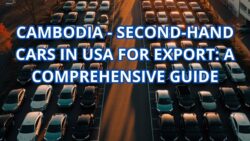Key takeaways:
- The 20/3/8 rule helps keep car payments manageable by suggesting a 20% down payment, a 3-year loan, and monthly costs under 8% of gross income.
- Following the 20/3/8 rule may limit car choices and lead to higher monthly payments due to the shorter loan term.
- Don’t forget to get the vehicle history report to examine the car’s condition and value to make sure you purchase the best one that fits right into your budget.
The 20/3/8 rule is a car-buying guide that recommends every car buyer to pay 20% for the down payment, finance the car for a maximum of three years, and ensure the monthly car payment is a maximum of 8% of their gross monthly income. This method is designed to prevent financial strain and limit the impact of interest and depreciation.
The 20/3/8 Explained
Not everyone has the privilege of paying for a car in cash; some might prefer to take out a bank loan or an auto loan, which can be risky. Often, the only cars affordable with cash are old and in very poor condition.
However, with the right method, you can purchase a car with your money without hurting your cash flow, and it is called the 20/3/8 method.
The scheme of the 20/3/8 method is like this:
- Pay a 20% down payment
- Finance the car for no more than 3 years.
- Keep your monthly car payment below 8% of your gross monthly income
The main idea of this method is to stop buyers from overspending and to reduce rates, interest, debt, and a car’s depreciation.
Let’s break it down:
If your monthly income before tax is $5,000, 8% means your total monthly car payment (including principal and interest) should not exceed $400. By paying 20% upfront and limiting the loan to 36 months, you save money on interest and build equity faster.
Components of the 20/3/8 Rule
The 20/3/8 rule is a financial guideline to help individuals make smart decisions when buying a car. It has three main parts: a 20% down payment, a three-year loan term, and keeping monthly car payments under 8% of gross income. Each part helps buyers stay financially stable.
20% Down Payment
The first part recommends putting at least 20% down on a car. A larger down payment reduces the loan amount, lowers total interest paid, and prevents being “upside down,” where you owe more than the car’s value. It also makes monthly payments smaller and easier to manage.
3-Year Loan Term
The second part suggests paying off the car loan in three years. Shorter loans usually have lower interest rates and help buyers pay off debt faster. A shorter term also reduces the risk of the car depreciating faster than the loan balance, which is a common issue in auto financing.
8% of Monthly Income
The final part recommends keeping car payments below 8% of gross monthly income. This ensures car expenses, including insurance and maintenance, stay affordable and don’t overstrain the budget. Following this guideline helps buyers manage money responsibly while owning a car.
Is the 20/3/8 Rule Based on Gross Salary?
Yes. Using the gross amount makes it easier to set the budget; however, it’s important to remember that not everyone has the same financial situation.
If your take-home pay is much lower due to taxes, loans, and living expenses, you may adjust the 20/3/8, for example, keeping the monthly payment below 6% of your net income instead of 8%.
The goal is to find the right car that does not need to stretch your financial condition, as the rules help guide you to the maximum limits of how much you should spend on a car’s financing.
The 20/3/8 Calculator: Calculating the Right Amount
You don’t need to use a fancy calculator to calculate how much money you should spend on a car’s financing, as basic math will do the trick.
Here’s a simple formula to calculate the 20/3/8 method
Calculate 8% of Your Gross Monthly Income
First thing, you will need to know 8% of your gross income to set the maximum monthly payment.
Formula
Max Monthly Payment = Gross Monthly Income × 0.08
Example
- Gross monthly income: $5,000
- 8% of $5,000 = $400
It means that your monthly car payment should stay at or below $400.
Choose a Loan Term Under 36 Months
The “3” rule is the maximum time to finance the car; in this case is 3 years maximum (or less is better). The purpose of this is to lower the interest, loan rate, and you’ll own the car faster.
Plan the Down Payment
The “20” in the rule is your upfront payment. This means you should be paying 20% of the car’s price for the down payment.
Formula:
Down Payment = Car Price × 0.20
Example:
- Car price: $25,000
- Down payment: 25,000 × 0.20 = $5,000
Estimate Total Car Cost
Remember to include taxes, registration, insurance, and maintenance. Even if your monthly payment fits the rule, extra costs can affect your budget.
Formula:
Total Car Cost = Car Price + Taxes + Registration + Insurance + Maintenance − Down Payment
Before you decide to purchase a car, make sure you know the car’s market value to know about your dream car’s market price.
How to Apply the 20/3/8 on the Car’s Financing Method?
Buying a car does not need to be expensive nor financially hurt you, as long as you follow the right method and its rules; everything would be fine. This is how to apply the 20/3/8 rules that can help you stay on budget and avoid financial stress.
- Know your income and expenses: Start with your gross monthly income, then review all bills, debts, and other recurring expenses. This gives a clear picture of how much you can safely allocate toward a car.
- Set a clear car budget: Use the 8% rule as a guide: your total monthly car payment, including insurance and maintenance, should not exceed 8% of your gross monthly income. This ensures your purchase fits within your overall financial plan.
- Save for the down payment: Aim for at least 20% down. A larger down payment lowers the loan amount, reduces interest paid, and decreases monthly payments.
- Compare car types wisely: If a new car doesn’t fit your budget, consider a reliable used or certified pre-owned model that meets your needs for space, features, and reliability.
- Stick to shorter loan terms: Choose a 3-year (36-month) loan if possible. While monthly payments are higher than longer loans, you save on interest and pay off the car faster, keeping your finances healthier.
Read also: How to check car history online before you buy
What are the Pros and Cons of Following the Car 20/3/8 Rules?
Like any financial rule, the 20/3/8 method has its pros and cons you should consider before running the rules. Here are the best benefits of using this method to finance your car.
The Pros of the 20/3/8 Method
- Lower interest costs: Shorter loans reduce the total interest paid.
- Better budget control: Keeping your car costs within 8% of your income helps maintain financial stability.
- Balanced spending: The rule ensures you have money for other important expenses and lifestyle needs.
Cons of the 20/3/8 Method
- Higher monthly payments: Shorter loan terms mean higher monthly instalments. You must be prepared to make each payment on time.
- Limited options: Following strict 20/3/8 targets may narrow the range of cars you can afford, making it harder to get exactly what you want.
- Missed Financing Opportunities: Focusing only on a short-term loan might make you miss special offers for longer-term financing or other deals that could be financially advantageous.
So, Should You Do the 20/3/8 Rules When Financing a Car?
Yes, if you know how to set the budget just right. The 20/3/8 method suggests a 20% down payment, a three-year loan term, and keeping monthly car payments and expenses under 8% of your income.
Before you decide to purchase a car, it’s crucial to examine your financial condition to set a realistic budget for the car. Don’t forget to check the car’s MSRP and original specifications through the window sticker to see if it fits your needs and budget.
Frequently Asked Questions on the 20/3/8 Rule
Why the 20/3/8 Rule Works?
The 20/3/8 rule works because it helps you manage your money and think about long-term finances. Making a bigger down payment and choosing a shorter loan term can help you own more of the car faster and avoid owing more than it is worth.
Keeping your monthly car payment under 8% of your income also helps you stay within your budget and still have money for other things like saving, paying debts, or investing.
What is the 20/3/8 rule for Money Guy?
The 20/3/8 rule helps you see how much you can spend on a car without stretching your budget. It suggests putting 20% down, paying off the car in three years, and keeping your total monthly car payment at or under 8% of your gross income. The 8% limit is for all your vehicles combined, not for each one.
What is Dave Ramsey's rule on car-buying?
Dave Ramsey’s rule says it is best to pay for a car in cash. If you cannot, then you may not be able to afford it. He also suggests that the total value of all your cars should be no more than half of your yearly income. For most people, buying a good used car is better than a new one, unless you are very wealthy.








